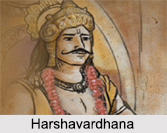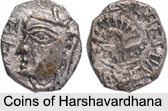 One of the most important Indian emperors of the 7th century, Harshavardhana was a Buddhist convert in a Hindu era, whose reign seemed to mark the transition from the ancient to the medieval period, when decentralized regional empires continually struggled for dominance. Harshavardhana was a part of the Pushyabhuti dynasty also known as the Vardhana dynasty, which came into prominence after the downfall of the Gupta Empire.
One of the most important Indian emperors of the 7th century, Harshavardhana was a Buddhist convert in a Hindu era, whose reign seemed to mark the transition from the ancient to the medieval period, when decentralized regional empires continually struggled for dominance. Harshavardhana was a part of the Pushyabhuti dynasty also known as the Vardhana dynasty, which came into prominence after the downfall of the Gupta Empire.
Ascension of Harshavardhana
The second son of Prabhakaravardhana, the king of Thaneswar, Harshavardhana was crowned at the age of 16 years after the assassination of his elder brother, Rajyavardhana. It was King Shashanka, the ruler of Gauda in Eastern Bengal who murdered Rajyavardhana. After the unfortunate death of his brother, Harshavardhana marched against the treacherous king of Gauda and killed Shashanka in a battle.
Reign of Harshavardhana
Harshavardhana ruled over the entire North India from 606 to 647 CE and united the small republics from Punjab to Central India. Under the rule of Harshavardhana, there was a vast unified empire which underwent considerable expansion and grew to include the Punjab, Rajasthan, Gujarat, Bengal, Odisha and the entire Indo-Gangetic plain north of the Narmada River. He proved himself to be an able administrator and presided over a kingdom where peace and prosperity prevailed for most of the time.
Harshavardhana"s capital Kannauj, modern day Uttar Pradesh, attracted many artists, poets, religious leaders and scholars who travelled from far and wide. Harsha"s Sanskrit court poet Banabhatta authored his biography, "Harshacharita", where he described Harsha"s association with Thaneswar, besides mentioning the defence wall, a moat and the palace with a two-storied Dhavalagriha or a white mansion.
 Under his administration the economy became increasingly self-sufficient and feudal in nature. Over a period of time trade started declining and commerce receded. The diminishing trade and commerce also affected other industries and thus the people grew increasingly dependent upon agriculture. As the king Harshavardhana maintained good relations with Emperor Taizong of the Tang Dynasty in China. Chinese pilgrim Xuanzang spent several years in India and following his visit, Harshavardhana sent a mission to China which established the first diplomatic relations between China and India.
Under his administration the economy became increasingly self-sufficient and feudal in nature. Over a period of time trade started declining and commerce receded. The diminishing trade and commerce also affected other industries and thus the people grew increasingly dependent upon agriculture. As the king Harshavardhana maintained good relations with Emperor Taizong of the Tang Dynasty in China. Chinese pilgrim Xuanzang spent several years in India and following his visit, Harshavardhana sent a mission to China which established the first diplomatic relations between China and India.
Harshavardhana tried to extend his empire to the southern peninsula of India but was defeated Pulakeshin II of the Chalukyan dynasty, who proposed a treaty with Harshavardhana. The main term of treaty was that the Narmada River was designated as the border between the Chalukyan and the Vardhana Empire.
Religion followed by Harshavardhana
Harshavardhana"s ancestors were sun worshippers, but Harshavardhana was a Shaivite. He was an ardent devotee of Lord Shiva, in fact in the Sanskrit play "Nagananda" which was written by Harshavardhana himself was dedicated to Lord Shiva"s consort Goddess Parvati. According to the Chinese Buddhist traveller Xuanzang, Harsha became a devout Buddhist at some point in his life. Harshavardhana built hospices and ordered his men to maintain them well. These hospices served as shelters to the poor and to the religious travellers across India. He also organized a religious assembly called Moksha, which was organized once in every 5 years.
Harshavardhana was also renowned for organizing a grand Buddhist convocation in 643 CE. This convocation was held at Kannauj and it was attended by hundreds of pilgrims and 20 kings who had come from far and wide. Xuanzang also describes a 21-day religious festival organized by Harsha in Kannauj. During this festival, Harshavardhana and his subordinate kings performed daily rituals before a life-sized golden statue of the Buddha.
Harshavardhana built many stupas and viharas and forbade the slaughter of all sorts of creatures. He passed away on about 647 AD. After his death there was an utter chaos and disorder in Northern India. He died without any heir and his entire kingdom was divided into many parts and various rulers took charge of those parts. He made endowments to the University of Nalanda, where 2 seals of Harsha have been found there.






































